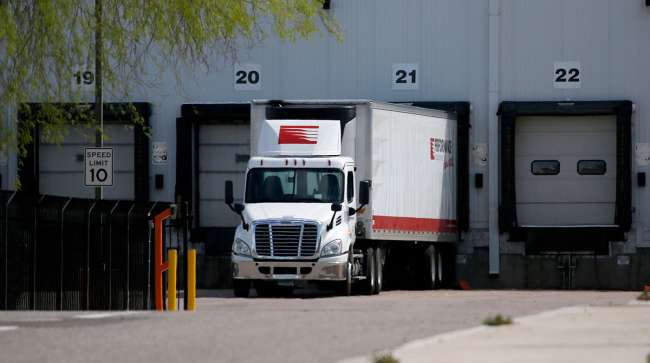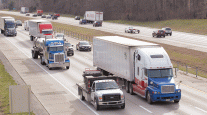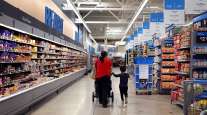Senior Reporter
Trucking Industry Economy Outpaces US Economy as Capacity Tightens

[Ensure you have all the info you need in these unprecedented times. Subscribe now.]
Trucking is providing one of the few bright spots to the flagging U.S. economy as tight capacity and a driver shortage push contract and spot rates higher across vans, flatbeds and refrigerated trucks.
DAT Solutions said van spot load rates in September were up 28.8% compared with a year ago. They have continued to rise in October and now average $2.46 per mile, a 9-cent increase since the beginning of the month. Flatbed rates are up 9.9% year-over-year and have jumped a nickel in the past two weeks, also to $2.46 a mile. Refrigerated rates are up 19% year-over-year — and 3 cents in the past two weeks — to $2.60 per mile.
Bob Costello, chief economist at American Trucking Associations, told Transport Topics capacity in the industry is as tight as it has been in years.
September Pulse Signal: Spot rate increases have started pulling contract rates up – although at a slower, more muted pace. Download the free Pulse Signal Report: https://t.co/J3M8eKneo4 — DAT Freight & Analytics (@LoadBoards) October 13, 2020
“Parts of trucking are doing very well,” he said. “On the supply side, there are a number of factors that have come together that each of them on their own would not have caused a tight capacity situation, but taken together they are causing things to tighten.”
Costello said an undetermined number of fleets closed early on because of the COVID-19 pandemic, and those that are continuing to operate are likely running with fewer trucks.
READ MORE: E-Commerce Spike Likely to Outlast COVID-19 Pandemic, Experts Say
“The spot markets are very strong because there is a lot of spillover freight, Costello said. “Contract freight is up, but I think capacity has a much bigger impact on this issue.”
The recently released Logistics Managers Index reached 70.5 in September, the highest number since October 2018. As recently as April, the index reached an all-time low of 51.3.
“September’s robust readings are driven primarily by the tightening capacity in both transportation and warehousing as the demand for logistics services increases ahead of the fourth quarter,” the report said. “E-commerce is expected to be at record-high levels during the holidays, and retailers are restocking their inventories, especially those coming from international suppliers that had seen difficulty making regular deliveries early on during the lockdown.”
Economist Stephen Burks at the University of Minnesota-Morris monitors the transportation and trucking economy. The former less-than-truckload driver told Transport Topics the industry is strong, but the U.S. economy’s overall shape is uneven.
“All the different parts of the transportation system economy are still running, but some are running more strongly than others and some are depressed,” Burks said. “The overall mixture has shifted a bit, more toward e-commerce fulfillment.”
ATA’s Costello and Rajeev Dhawan, director of the Economic Forecasting Center at Georgia State University, said the U.S. economy runs the risk of slowing considerably as the White House and Congress have been unable to reach an agreement on a new stimulus bill.
The current White House proposal is for a $1.8 trillion package, less than the $2.2 trillion bill put forward by Democrats. House Speaker Nancy Pelosi said the counteroffer President Donald Trump made Oct. 9 “amounted to one step forward, two steps back.” But several Republican senators said they’re concerned by the price tag associated with the bill.

Over the past few episodes, we've had the chance to listen to the experiences of industry leaders and the strategies and planning that go into finding the right people for your workforce. Host Michael Freeze reviews the most important bullet points, from technician and driver training to incorporating diversity in recruitment and retention. Hear a snippet, above, and get the full program by going to RoadSigns.TTNews.com.
If no new stimulus bill is approved, the economists fear that the economy could have a so-called K-shaped recovery, in which people with incomes at the top see their situations improve. In contrast, those with lower incomes see things get worse.
“Parts of the economy, e-commerce, home improvement, residential construction are doing very well, and that means parts of trucking are doing very well,” said Costello. “But parts of the economy are doing atrocious — travel and tourism, entertainment, services.”
Georgia State’s Dhawan said that in the early months of the pandemic, millions of Americans stocked up, and if they had the opportunity to work from home, they spent money to improve home offices.
“We did buy extra electronic equipment in the last six months, we did buy extra furniture to work from home, but we’re done with all of that,” Dhawan said. “The rate of spending will likely slow.”
Federal Reserve Chairman Jerome Powell also is among those sounding the alarm if no new stimulus bill is passed. Powell said the risks of Congress and the White House putting too much additional stimulus into the economy are lower than the risk of not doing enough. Although government spending is adding to an already high federal budget deficit, Powell urged lawmakers to act.
“The U.S. federal budget is on an unsustainable path, has been for some time,” Powell said. “[But] this is not the time to give priority to those concerns.”
On Oct. 29, the Bureau of Labor Statistics will announce the gross domestic product for the third quarter.
Costello, Burks and Dhawan expect record-setting growth, but not enough to make up for the second quarter’s record drop of 31.7%.
Want more news? Listen to today's daily briefing:
Subscribe: Apple Podcasts | Spotify | Amazon Alexa | Google Assistant | More




